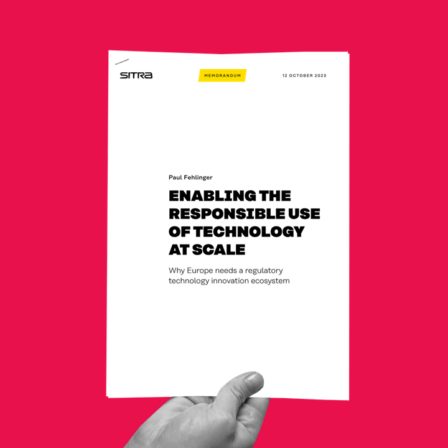The European Single Market Strategy is the latest EU initiative simplifying regulation to support innovation-driven growth. Together with the Omnibus packages and the Startup and Scale-up Strategy, the European Union aims to reduce unnecessary reporting burdens and make itself a top destination for digitally savvy companies to launch and scale.
However, simply cutting red tape is not enough. A smarter, technology-enabled approach to rule-making and enforcement can help businesses follow the rules with the fraction of current costs. This in turn can boost innovation, cut costs and support competition.
These were some of the key messages from an event co-hosted by Sitra and Euractiv in Brussels in May 2025. Leaders in policy, business and research across Europe agreed: it is time to modernize compliance with technologies, especially for small and medium-sized enterprises (SMEs).
Europe has now a unique chance to turn its legal stability and technological excellence into a competitive advantage. Yet, there are no opportunities or time to waste. Following the discussion, the European Union must move forward with determination in the three key areas.
1. Quality over quantity: Smarter regulation, not just less
Clear, well-designed rules are the backbone of a fair society and the European single market. Yet a noble objective alone does not guarantee that rules are easy to understand and follow in practice, especially for smaller businesses.
In her keynote address, Executive Vice-President for Tech Sovereignty, Security and Democracy of European Commission Henna Virkkunen noted that European companies spend around 150 billion euros annually on compliance, with one in three SMEs spending over 10 per cent of staff time just to navigate legal obligations.
The Commission is set to reduce reporting burdens by 25 per cent overall (and by 35 per cent for SMEs). Several simplification packages have already been rolled out, which are welcome steps. But more than cuts from essential safety rails, such as fair competition and consumer safety, it is crucial to make rules as easy to apply and understand as possible.
Example: Finnish startup Lean Entries created a tool that helps businesses determine which obligations apply under laws like the AI Act, the Data Act and the EHDS Regulation. Unlike generative AI tools like ChatGpt, the Entries tool is built on a high-quality database combining legislation and related materials, and therefore it does not hallucinate or cut corners.
2. From ideas to implementation: Tech is the key to making simplification real
Digital tools already help banks manage complex rules (financial technologies, FinTech). Jyrki Katainen, Head of Group Public Affairs at Nordea Bank and former Vice-President of the European Commission, highlighted how compliance technologies are not just a cost but a strategic enabler helping banks to identify anomalies, reduce fraud, streamline reporting and enhance governance.
Automated reporting, machine-readable laws and real-time tracking allow businesses to stay up to date with requirements and reduce manual work in sectors facing a myriad of evolving regulation, like artificial intelligence, cybersecurity, sustainability, and data governance. The same tools also benefit the public authorities. For example, the Sitra-funded Lex GPT pilot explored how generative AI can support the interpretation of complex legal texts, demonstrating the potential of language models to enhance the efficiency of legislative drafting processes.
Executive Vice President Henna Virkkunen summed it up: On the one hand, compliance with the AI Act needs to be simplified, and on the other hand, AI needs to be used to aid compliance with other regulations, “AI-boosted RegTech”.
Initiatives like the European Business Wallet and Digital Product Passports show the EU is moving in the right direction. But we need broader deployment and more ambition.
Example: Kuurai, a Finnish startup, has built a platform to help businesses comply with the EU’s Corporate Sustainability Reporting Directive (CSRD). It automatically gathers and structures the data from business activities, highlighting opportunities to reduce emissions and costs.
3. In global turmoil, clear rules are a strength
The European Union is built on the rule of law. In a world marked by uncertainty, legal certainty is a unique strength. The next leap is to turn compliance into a source of competitive edge.
Regulatory technologies can turn compliance from a burden into a growth enabler by shifting effort from manual and bureaucratic reporting to value creation.
Example: In data economy initiatives like Sitra’s Fair Data Rulebook, shared tools and standards help organisations share more data across sectors and borders with greater confidence about complying with regulatory requirements. Similarly, digital product passports offer data-based tools to improve production chains and management in a compliant manner.
Example: In Czechia, the Chamber of Commerce has developed a digital platform that maps business obligations across legislation. It shows companies which rules apply to them, and helps regulators spot duplicate or outdated requirements.
The way forward
The European Union has a real opportunity to lead by showing how smart regulation and technologies can go hand in hand. The transition is big but so are the benefits.
Sitra has facilitated collaborative discussions on the topic and brought together businesses and policy-makers to find common vision and steps forward. Broad collaboration is a good place to start iterating the approach.
Read more
Op-Ed (Euractiv): Why technologies are the missing piece in the EU’s simplification efforts


